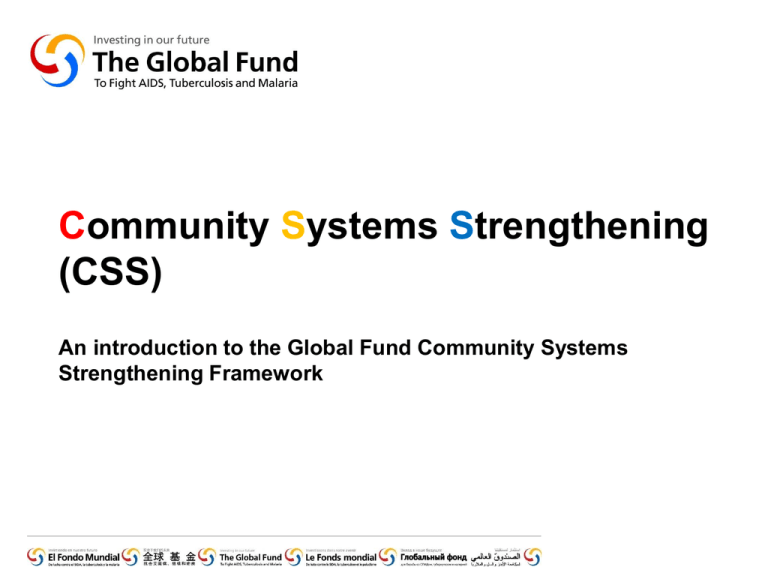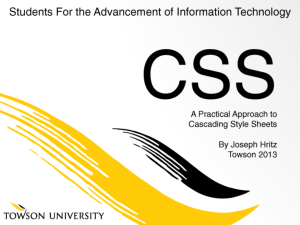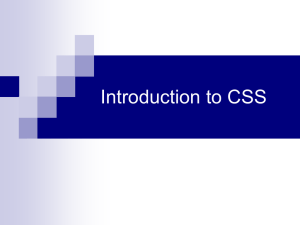Community Systems Strengthening
advertisement

Community Systems Strengthening (CSS) An introduction to the Global Fund Community Systems Strengthening Framework Outline 1. CSS in the context of the Global Fund 2. Introduction to the CSS Framework – a tool developed by the Global Fund and its partners 3. Next steps, and towards Round 11 Community Systems Strengthening Requesting funding for community-level activities has always been possible. In 2008 the Board of the Global Fund requested routine inclusion in proposals of measures for strengthening of community systems, including Initiatives that contribute to the development and/or strengthening of community-based organizations , in order to: • Improve knowledge of, and access to, improved health service delivery • Achieve improved outcomes for HIV, TB and malaria prevention, treatment, care and support programs Challenges around CSS for Civil Society • Lack of awareness by beneficiaries and CCMs of the existence of the CSS opportunity • Lack of evidence-based documentation and related indicators to show impact of CSS • Confusion and overlap between HSS and CSS • Lack of resources and appropriate technical assistance to help civil society contribute good CSS components to proposals Community Systems Strengthening Aim of CSS and the Framework “The CSS Framework is aimed at strengthening community systems to contribute to key national goals and to ensure that people’s rights to health are realised. This includes prevention, treatment and care, mitigation of the effects of major diseases and the creation of supportive and enabling environments in which these systems can function.” The CSS framework is intended to help countries include funding for community organizations and activities in their proposals. How does CSS work? • Community Systems Strengthening areas of activity may include a focus on: – Building capacity of the core processes of community-based organizations to provide an increased range, or quality of services. – Building partnerships at the local level to improve coordination, enhance impact, and avoid duplication of service delivery. – Sustainable financing, including a focus on supporting initiatives to plan for and achieve predictability of resources over a longer period of time with which to work for improved impact and outcomes for the disease(s). Community Systems Strengthening Six Core Components in CSS Framework 1. Enabling environments and advocacy 2. Community networks, linkages, partnerships and coordination 3. Resources and capacity building 4. Community activities and service delivery 5. Organisational and leadership strengthening 6. Monitoring & evaluation and planning + Menu of Service Delivery Areas + Examples of Activities + Menu of recommended Indicators Service Delivery Areas (SDAs) • Examples of possible SDAs are proposed for each core component • Proposals can include these SDAs, or others can be developed according to the context and intended services • SDAs can be included in Global Fund proposals or applied in other planning tools. SDAs in detail 1. Enabling environment and advocacy: SDA1: Monitoring and documentation of community and government interventions SDA 2: Advocacy, communication and social mobilization 2. Community networks, linkages, partnerships and coordination: SDA 3: Building community linkages, collaboration and coordination 3. Resources and capacity building SDA 4: Human resources: skills building for service delivery, advocacy and leadership SDA 5: Financial resources SDA 6: Material resources – infrastructure, information and essential commodities SDAs in detail (cont’d) 4. Community activities and service delivery: SDA 7: Community-based activities and services – delivery, use, quality 5. Organizational and leadership strengthening: SDA 8: Management, accountability and leadership 6. Monitoring & Evaluation and Planning: SDA 9: Monitoring & Evaluation, evidence-building SDA 10: Strategic and operational planning Community Systems Strengthening Service Delivery Areas and Goals Core Component SDA Goal I. Enabling Environment & Advocacy Monitoring of community & government interventions CBOs analyze and document relevant issues. II. Community Networks, linkages, partnerships and coordination Building community linkages, collaboration and coordination Functional networks, partnerships between community actors and national programs are in place for effective coordination. III. Resources & Capacity Building Human Resources Financial Resources Material Resources Knowledge of community health, rights, social environments; core funding secured with sound financial management; functional systems to forecast, quantify and manage infrastructure. IV. Community Activities & Service Delivery Delivery, use and quality of community-based activities and services Effective, safe, high quality services are equitably delivered to those in need. V. Organisational and leadership strengthening Management, accountability and leadership Community actors provide leadership in the development, operation of programs. VI. Monitoring & Evaluation and Planning M&E and evidenc building Relevant data is collected, analyzed, used and shared and it informs strategic planning. Community Systems Strengthening Examples for Indicators SDA 1: Monitoring and documentation of Number/percentage of CBOs that have been involved in joint community and government interventions program reviews or evaluations in the last 12 months SDA 2: Advocacy, Communication and Social mobilisation Number/percentage of CBOs that implemented a costed SDA 3: Building community linkages, collaboration and coordination Number/percentage of CBOs that are represented in national or provincial level technical and policy bodies SDA 4: Human resources: skills building for service delivery, advocacy and leadership Number/percentage of volunteers working for CBOs that are provided with a stipend/allowance SDA 5: Financial resources Number and percentage of CBOs that have core funding secured for at least 2 years Full CSS Framework: communication and advocacy plan in the last 12 months http://www.theglobalfund.org/documents/civilsociety/CSS_Framework.pdf The Challenge: Measuring Impact Ultimately, we are trying to measure the impact of Global Fund grants (and national AIDS programs) by using indicators such as: 1) Reduced HIV transmission (reduced incidence) 2) Reduced Mortality (i.e. keep people alive) 3) Improved health of target populations The Challenge: Measuring Impact Community-based organizations are essential actors in: 1.Delivering services to target populations 2.Linking and referring between services (e.g., VCT, ART) 3.Providing support and information (e.g., counseling, BCC) 4.Documenting barriers to effective interventions, and 5.Advocating for improved policies and policy implementation, However, from an M&E perspective strengthening of community systems/groups (CSS) has a secondary rather than direct effect on project outcomes. CSS: Indirect but Still Essential Input Strengthening interventions Output Impact Quality services are available and used by the community Health is improved at the community level CC 1: Enabling environments and advocacy CC 2: Community networks, linkages, partnerships and coordination CC 3: Resources and capacity building CC 4: Community activities and service delivery CC 5: Organisational and leadership strengthening CC 6: Monitoring & evaluation and planning Linked: Health and Community Systems Like Health Systems, Community Systems are critical to effective service delivery. They are often part of a continuum of care, such as when peer outreach workers refer PLHIV to testing or care centers, health systems deliver medical care, and then peer counselors deliver follow-up information and counseling. Health System Community System VCT/ART Refer to VCT/ART Refer to MMT/NSP MMT NSP Impact Counselling Counselling Reduced HIV+ VCT Reduced Mortality ART Reduced Mortality Measuring long-term Impact of CSS Many of the activities in the CSS Framework are linked to important outcomes, but it is very hard to quantify a clear causal relationship. For example: CSS Activity: Training for treatment counselors Long-term impact: leads to faster ARV uptake and improved adherence, leading to decreased mortality. CSS Activity: Training for peer outreach workers Long-term impact : increased coverage of outreach to IDU, increasing referrals to harm reduction services and reducing HIV transmission. CSS Activity: Provide stable salaries for CBO staff and volunteers Long-term impact : Stable and effective outreach and provision of services, data collection, and monitoring of project outputs. Analysis on Community Systems Strengthening (CSS) Round 10 CSS and the Global Fund • The Global Fund recognizes that strong, sustainable community-based organizations are key to ensuring program impact, sustainability, equity, and results for HIV, tuberculosis, and malaria prevention, treatment, care and support efforts. • For this reason, from Round 8 onwards, the Global Fund began explicitly encouraging applicants to routinely include measures to strengthen community systems that are relevant to in-country contexts both for new and continued funding. • Community System Strengthening (CSS) refers to initiatives that contribute to the development and/or strengthening of community-based organizations in order to improve knowledge of, and access to improved health service delivery. CSS Framework In Round 10 applicants could refer for the first time to the CSS Framework to include CSS in their disease proposals or crosscutting HSS funding requests. • The framework provides a detailed description of the CSS rationale and core components. • It includes a number of recommended CSS indicators to enable measurement of progress in CSS over time. • Thanks to this we are now able to capture the level of funding directed to CSS activities. Methodology The report provides an analysis on the amounts requested and types of CSS activities that were proposed by applicants in Round 10. Categories the analysis examines: 1. All proposals received Sub-Categories: Global Fund Cluster • LAC, MENA, SWA, WCA, EAIO, EECA, SA and EAP 2. Proposals recommended for funding (Cat 1, 2, and 2B) Income Level 3. Financial Analysis Sector • Lower Income, Lower Middle Income, Upper Middle Income and Mixed • Gov, Non-Gov, DTF 4. Indicators and core components (as indicated in the CSS Framework) 5. Survey completed by applicants in regards to CSS Components • HIV, HIV (MARPS), TB, Malaria, HSS Outcome and CSS for all proposals received 49% of the 189 Round 10 proposal parts received included CSS activities. Outcome and CSS for recommended proposals 44% of the 88 proposal parts recommended for funding by the TRP included CSS activities. CSS by Region Proposals from LAC (71%) included CSS activities significantly more often than the other regions (25% - 56%) 80% 71% 70% 56% 60% 50% 50% 50% 48% 48% 43% 40% 25% 30% 20% 10% 0% LAC MENA SWA WCA EAIO SA EECA EAP CSS by Disease The percentage of funding requested for CSS-related activities in HIV (MARPs) proposals is significantly higher than the other disease components. 25.00% 24.52% 20.00% 15.00% 10.00% 4.96% 5.00% 2.05% 1.62% 1.62% 0.00% HIV (MARPS) HSS HIV TB Malaria CSS by PR Sector The percentage of CSS activities allocated to PRs from the government sector was highest, followed by the non-government sector and DTF proposals. CSS by SDA for all proposals including CSS activities The SDAs regarding Human Resources (SDA 4), Community activities and services (SDA7), and Community networks, linkages, partnerships and coordination (SDA3) were mentioned most often. The SDAs mentioned least often are SDA 5 – Financial Resources and SDA 10 – Strategic Planning. Conclusions • Awareness of CSS is uneven – Throughout the regions – Throughout the diseases • Capacity concerns are still prominent with regards to Civil Society PRs – Capacity building should remain a priority • Launching the CSS Framework for the first time – Service Delivery Areas (SDAs) were used frequently – Use of indicators less uniform – Generally good feedback received from applicants in survey Further action by the Global Fund • Analyze in more detail the feedback of the Technical Review Panel (TRP) to inform future technical assistance on CSS • Take lessons learned to improve CSS Framework and guidance on the use of CSS Framework Next Steps • Understanding the results of the analysis of CSS components included in Round 10 proposals • Review and update of indicators • Further information and training Share your views and experience: Michael.OConnor@theglobalfund.org Ntombekhaya.Matsha@theglobalfund.org Further Information • The CSS Framework on the Global Fund website: www.theglobalfund.org/documents/civilsociety/CSS_Framework.pdf • UNAIDS Guide on CSS: http://data.unaids.org/pub/BaseDocument/2010/201007_unaidscss_en.pdf • Technical Support: UNAIDS TSF, GTZ, RBM, Stop TB and civil society specific: CSAT







